 Your new post is loading...
 Your new post is loading...
The challenge for companies that do not have the creative freedom to begin at square one is how do we create that same culture of innovation? How do we build an environment where we are comfortable at chipping away the things that no longer add value? How many systems would we switch off as opposed to trying to integrate them with the new? How much complexity in our processes could we design out to create something that is elegant and simple? For me, this feels very different from how most large organizations function. But if we are going to create magnificent works of art within our day-to-day working lives, we need to embrace the concept of curation – of removing the superfluous and keeping only that which is beautiful in its simplicity....
When a company weathers a big change, it can be a test of leadership. Here's how what some CEOs who have been through it learned.
Sometimes it’s clear that the writing's on the wall for an organization: Things aren't going well. And during those times it’s even harder to communicate and lead.
Whether a company figures out its end vision is unattainable without the help of a deep-pocketed investor, or if it simply sees the financials and understands that the run rate is coming to a close, these are pivotal and emotional times for individuals at the top. More importantly, they're the hardest moments to strategize....
After talking with several business leaders who have steered companies during times of crisis, it’s clear that this is one of the most defining moments in an executive's career. When things are going swimmingly, a founder can gin up an image of success and determination. But when business goes south, that’s the real moment a leader needs to show his or her true colors....
Benjamin Franklin once said: “Tell me and I forget, teach me and I may remember, involve me and I learn.”
At the SAP Design & Co-Innovation Center (DCC) at SAP we frequently organize the so-called “Method Mondays”, a regular one-hour meeting series in which the team members share, practice, and test different methods.
In this article I would like to share the 5 methods with you that work best for us – it’s worth trying!...
Today, every manager has some version of the Tony Soprano problem. We’ve become used to hierarchal organizations optimized for specific tasks. Now we often find that we’re competing in a networked world in which the old rules don’t apply. Rather than traditional lines of authority, we need to start thinking in terms of ecosystems, platforms and movements....
But Medium isn’t just taking a revolutionary approach to digital publishing — it’s changing the way companies operate too. As one of the fiercest and most faithful adopters of Holacracy – a radical new theory of corporate structure — Medium is experimenting with a completely management-free environment that’s laser focused on getting things done. Stirman couldn’t be more thrilled with the results: the freedom, the momentum, the productivity are all unparalleled, he says.
But companies don’t have to go all-in on Holacracy to reap the benefits. If his transition from Twitter to Medium taught him anything, there are always more tactics to try to make things work better. Below, he shares his lessons from taking the leap....
Jack Ma transformed China’s export economy with Alibaba, the retail giant poised to overtake Walmart with the biggest market debut in US history.
Jack Ma, China’s leading internet entrepreneur, once described himself as a “crocodile in the Yangtze”. The technology chief was busy discussing the battle between Alibaba, the online shopping company he founded, and eBay, the global auction site which used to dominate the Chinese shopping market.
“If we fight in the ocean, we lose; but if we fight in the river, we win,” he claimed. He proved his point when Alibaba’s Taobao auction site overtook eBay’s Chinese business and left it for dust. But that is not the only way Ma’s colourful analogy resonated.Ma has also demonstrated a crocodile’s ability to stalk his prey largely undetected....
Nooyi says she isn't sure her daughters would say she's a good mom.
While interviewing Indra K. Nooyi, the CEO of PepsiCo, at the Aspen Ideas Festival Monday*, David Bradley, who owns The Atlantic, asked two questions that elicited as frank a discussion of work-life balance as I've seen from a U.S. CEO. Below is a lightly edited transcript. The second question was preceded by a brief discussion of Anne-Marie Slaughter's "Why Women Still Can't Have It All.".
The problem with most business and leadership advice is that it's a little like this:
The two circles aren't the point. Getting the two circles right is a good idea, but lots of people manage that part. No, the difficult part is learning to see what an owl looks like. Drawing an owl involves thousands of small decisions, each based on the answer to just one question, "what does the owl look like?" If you can't see it (in your mind, not with your eyes), you can't draw it.
B2B marketing strategies are having to constantly change and adjust in the light of new trends driven by B2B buyers and technology. We have identified the key B2B marketing trends and how they may shape your future strategy. To keep this article short, as there is a lot to cover, we have put in links to more detailed articles as appropriate, should you want to read further.
Typically B2B marketing is segmented into outbound marketing such as email campaigns and inbound marketing such as SEO, social media and content marketing. The general shift has been towards inbound marketing as buyers increasingly manage the early stages of the buying process without contacting vendors by reviewing websites, talking to peers in the industry and reviewing resources. This allows them to often filter and shortlist without ever talking to a sales rep....
In a 2012 study on the state of marketing conducted by IBM, 52 percent of Chief Marketing Officers said that they are unprepared for the expected level of complexity over the next five years. Which only makes me wonder whether the other 48 percent were posturing, daydreaming when they answered the survey, or really think they have it all figured out.
From big data to the myriad of little dials we need to turn in managing our brands, there has never been more to do, less time in which to do it, and such a paucity of patience for poor performance.So what’s a marketer to do? Develop more sophisticated systems and tools? Invest in new methodologies and engagement strategies? Create deeper integration between every function in their business--from IT and Finance to Customer Service and Sales?
(Yes, yes, and yes.)...
Bland mission statements are worse than boring; they confuse your strategy. Let's start with a game. Below are three mission statements from three Fortune 500 companies. Try to match each company with its mission statement... How did you do? The largely indistinguishable statements make the task almost impossible. Such statements may still be considered "best practice" in some quarters but in so many cases they do not achieve what they were intended to achieve. Ironically, many "directional documents" are not fit for purpose: they do not provide direction.... [This was a refreshing POV and must-read ~ Jeff]
Forget trying to come up with motivational tools and "tricks." There's a better--and simpler--way to get more out of your staff. ..."I was sitting in front of my computer, trying to come up with something I could tell all these smart people in my company that would help them do their job better," Moorehead says, "and I realized that what I really should be doing is asking them what I should do."... [Inspiring advice for ALL managers - JD]
Want to know what Dirty Harry's leadership keys are? It's simple: No matter how badly things were going, Harry got results. ...Here are his five leadership keys — and you can use them, not shoot anyone, and still be a good company man or woman....
|
When is a project finished? For most of us, it seems pretty simple: when we ship the product or launch the service. But we need to take a step back and consider what “done” really means.
Most teams in business work to create a defined output. But just because we’ve finished making a thing doesn’t mean that thing is going to create economic value for us. If we want to talk about success, we need to talk about outcomes, not just outputs. And as the world continues to digitize and almost every product and service becomes more driven by (or at least integrated with) software, this need grows even stronger....
The success of a new breed of emerging brands can be attributed to doing business in the simplest way possible. Here's why simplicity rules.
At Siegel+Gale, we release an annual Global Brand Simplicity Index that examines the global state of simplicity for the world's leading brands.
The recent report also shows how consumers ranked 40 of the most prevalent, so-called "disruptive" brands in the US and UK. The disrupters outperformed the incumbent brands in every category, particularly in the US where, compared to their established counterparts, they took eight of the top 10 spots based on their simplicity score....
Say you have a startup idea. You assemble a team and in six months, you have a product you are actually confident to release. When that day finally comes, you launch and nothing happens. If you are lucky, you get an article on Techcrunch, a top spot in Product Hunt and several thousand users, but most of them stop using it after a few days.
I bet you were hoping for a huge, viral growth curve. Instead, you face with the harsh reality: you only have handful of users registered, and they are churning incredibly fast. At Piktochart we went through the same problem, that’s why in this post we’ll analyze 11 different growth hacking tactics that actually work...
Fast-moving technologies, rapid global expansion, shifting business models, mergers and acquisitions all hold out dazzling possibilities.
But leadership remains a huge challenge, even for companies relatively unscathed by the economic by economic turmoil. Today, employees continue to seek guidance from their leaders, who must find time to reassure their people while trying to establish a pole position for the future.Make sure to read....
...And so while we have dug into the data behind startups that have died (as well as those acqui-hired) and found they usually die 20 months after raising financing and after having raised about $1.3 million, we thought it would be useful to see how startup founders and investors describe their failures.
While not 50,000 ways it cannot be done, below is a compilation of startup post-mortems that describe the factors that drove a startup’s demise. Most of the failures have been told by the company’s founders, but in a few cases, we did find a couple from investors including Roger Ehrenberg (now of IA Ventures) and Bruce Booth (Atlas Venture). They are in no particular order, and there is something to learn from each and every one of them....
You might not have known it, but all those episodes of ‘‘The Simpsons’’ were just secret economics lessons. Turns out the yellowish, four-fingered cartoon characters have a lot of insight to offer on basic economic theory.
We know this thanks to Joshua Hall, an associate professor of economics at West Virginia University — and the brains behind the new book ‘‘Homer Economicus: The Simpsons and Economics’’ (Stanford University Press)....
...Managers in different parts of the world are conditioned to give feedback in drastically different ways. The Chinese manager learns never to criticize a colleague openly or in front of others, while the Dutch manager learns always to be honest and to give the message straight. Americans are trained to wrap positive messages around negative ones, while the French are trained to criticize passionately and provide positive feedback sparingly.
One way to begin gauging how a culture handles negative feedback is by listening to the types of words people use. More direct cultures tend to use what linguists call upgraders, words preceding or following negative feedback that make it feel stronger, such as absolutely, totally, or strongly: “This is absolutely inappropriate,” or “This is totally unprofessional.”
By contrast, more indirect cultures use more downgraders, words that soften the criticism, such askind of, sort of, a little, a bit, maybe, and slightly. Another type of downgrader is a deliberate understatement, such as “We are not quite there yet” when you really mean “This is nowhere close to complete.” The British are masters at it. The “Anglo-Dutch Translation Guide”, which has been circulating in various versions on the Internet, illustrates the miscommunication that can result....
In content marketing, your ability to execute strategy is as important – if not more important – than the strategy itself.
I had a marketing strategy professor who used to say, “A mediocre strategy with good execution beats a great strategy with poor execution every time.”He wasn’t promoting mediocre strategies. He was emphasizing the most important reason for strategic planning: to EXECUTE a strategy that achieves your business objectives.Otherwise, there’s no point in strategic planning....
When I first started in venture capital five years ago, I wanted to create a programmatic way to analyze companies well. My goal was to be able to step into a meeting with an entrepreneur with some kind of form that I would fill out throughout the meeting, so that by the end of the meeting I might have an understanding how the startup fits into its ecosystem.
It took quite a while to devise this framework and to revise it until it became useful, practical and insightful. I spoke with friends who were consultants and who analyze companies for a living. I read many books on the topics of competition and strategy. Last, I spoke with other investors.
But in the end I chose three simple frameworks that were already well-known and which fit together on two sheets of paper: The Business Model Canvas, Porter’s Five Forces, and Value Chain Analysis....
Even avid readers may be missing a genre valuable to their personal and professional development. ...I've written in the past about how business leaders should be readers, but even those of us prone to read avidly often restrict ourselves to contemporary nonfiction or novels. By doing so, we overlook a genre that could be valuable to our personal and professional development: poetry. Here's why we shouldn't. For one, poetry teaches us to wrestle with and simplify complexity. Harman Industries founder Sidney Harman once told The New York Times, "I used to tell my senior staff to get me poets as managers. Poets are our original systems thinkers. They look at our most complex environments and they reduce the complexity to something they begin to understand." Emily Dickinson, for example, masterfully simplified complex topics with poems like "Because I could not stop for Death," and many poets are similarly adept. Business leaders live in multifaceted, dynamic environments. Their challenge is to take that chaos and make it meaningful and understandable. Reading and writing poetry can exercise that capacity, improving one's ability to better conceptualize the world and communicate it — through presentations or writing — to others.... [Poetry in PR or your business? You may not want to present this idea to the CEO just yet. But if it gets results, it's a winner. A tantalizing and poetic approach to management. ~ Jeff]
To innovate, stop worrying about "failure" and start thinking of "learning."... ...For me, the most important insight from design thinking was that you have to make sure you've defined the right problem before you try to solve it. So, you act like an anthropologist to understand human needs and problems before jumping to solutions. Most of us in business, if we need to discover how to do something new, use PowerPoint or Excel spreadsheets to rationalize our approach. This is what I call "the illusion of rationality." Whether motivated by a lack of insight arrogance, or stupidity, the illusion of rationality is a waste of time and resources — yet one that keeps a lot of people employed in management consulting, as I learned first hand. Instead, if you don't have the data, you have to create the data. That does not mean plugging random numbers into your spreadsheet. It means generating real insight, from nothing. Designers and bootstrapped entrepreneurs I've worked with use rapid low cost experiments to create data. I refer to these "affordable losses" in the interest of learning, creativity, and discovery as "little bets." This seems like common sense; so why is it so hard? Three words: fear of failure. If you're an MBA-trained manager or executive, the odds are you were never, at any point in your educational or professional career given permission to fail, even on a "little bet." Your parents wanted you to achieve, achieve, achieve — in sports, the classroom, and scouting or work. Your teachers penalized you for having the "wrong" answers, or knocked your grades down if you were imperfect, according to however your adult figures defined perfection. Similarly, modern industrial management is still predicated largely on mitigating risks and preventing errors, not innovating or inventing....
...An organization’s best strategists are in the C-Suite, and the CEO is usually the catalyst. C-Suite strategists can draft an effective Strategic Plan within a day because they have an intimate knowledge of the business and are constantly thinking strategically. The best ones bring clarity and purpose to a document that can be written on just one piece of paper. Here are the key differences between the species...
|



 Your new post is loading...
Your new post is loading...




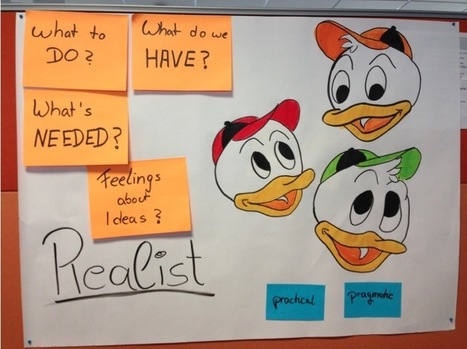






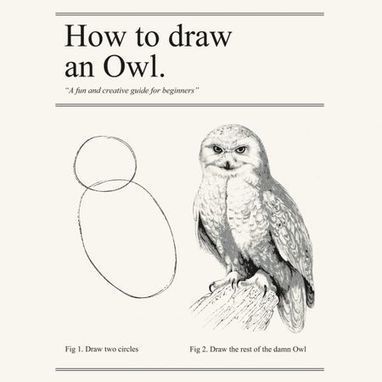



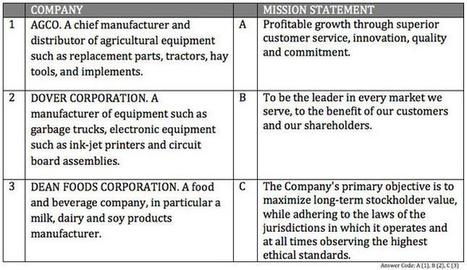

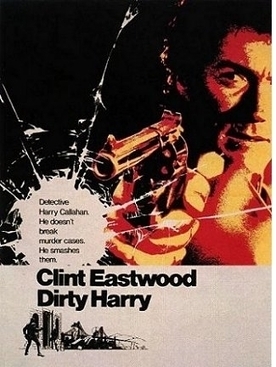








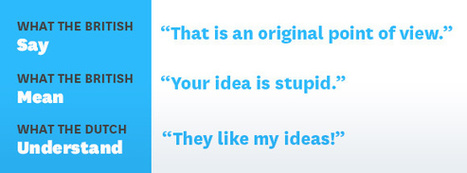

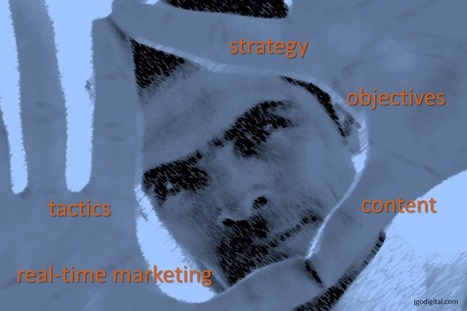
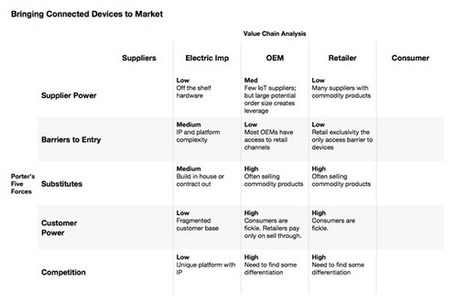









Elegant insight into why organizations need to embrace the concept of curation from Dr Hans Gerrits at KPMG Global.